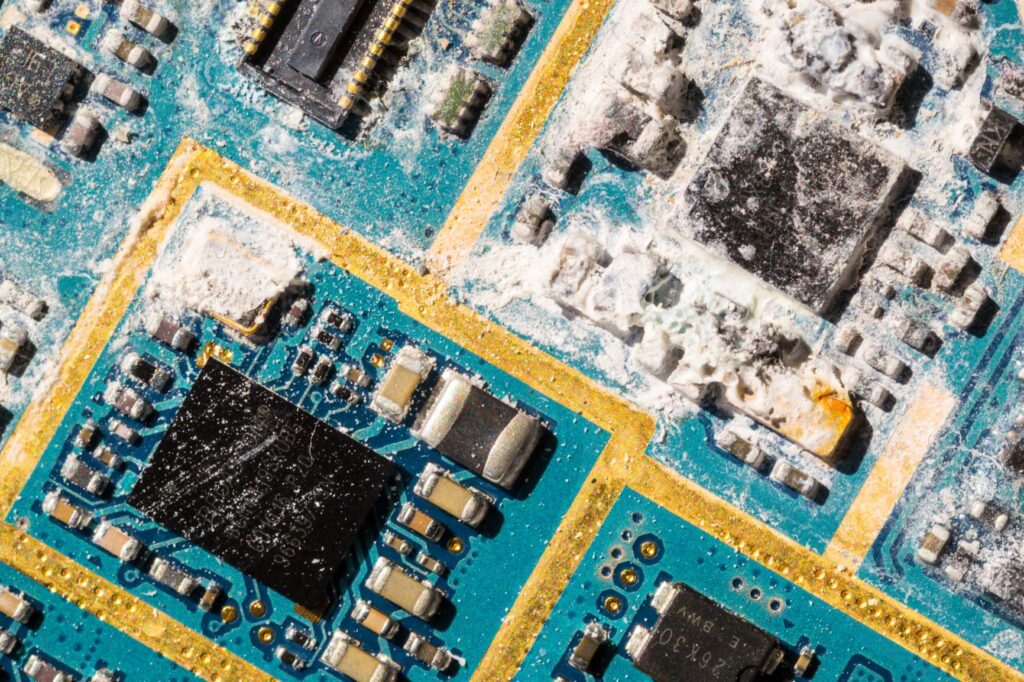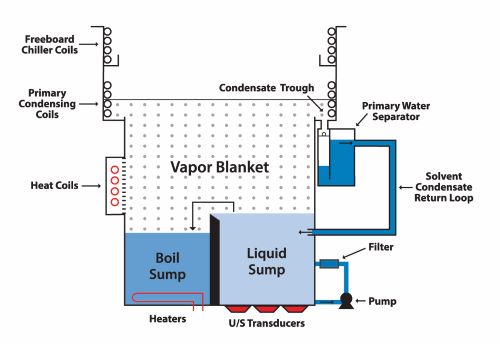By Emily Peck, Senior Chemist, MicroCare
Small, complex PCBs (printed circuit boards) used in modern electronics are often fabricated using no-clean solder and pastes. The original intention of no-clean products was that the no-clean flux residue could stay on the PCBs indefinitely and not negatively impact the lifespan or performance of the PCBs. No-clean solders and pastes were supposed to reduce both production time and labor by eliminating the need for cleaning circuit boards after reflow. Ironically, this time and cost saving idea is now proving to be more of a hindrance than a help.
Millions of electronic assemblies are made using no-clean solder pastes. For non-critical applications like inexpensive toys or single-use, disposable items, this works fine. However, for higher-reliability electronics used in the medical, aerospace or defense industries, the cleaning becomes critical. In other words, if a PCB were to fail due to flux reside contamination, it might result in some form of human catastrophe. Cleaning these PCBs is not optional. It is essential to ensure their long-term performance, functionality and reliability.
Many of these high-reliability PCBs are also growing in complexity while shrinking in size. They are multi-layered and tightly packed with bottom termination components like BGAs, CSPs, MLFs, QFNs, and D-Paks. Low standoff or zero clearance components are now the norm. This trend in circuit board miniaturization, complexity and high density may cause a greater likelihood for problems if the PCBs, especially those produced using no-clean solder pastes, are not properly cleaned.
Contaminated PCBs are susceptible to many types of trouble including parasitic leakage, electrochemical migration, shorting and dendrite growth. Today, the need to clean no-clean flux residue is no longer optional, it is essential to ensure long-term PCB performance, functionality and reliability.
White Residue is the Enemy
There are many different types of contaminants that can impact PCB performance. Solder balls may get trapped between tightly-spaced components. Ink and fingerprints may mar the surfaces. But white residue is really the enemy. When the salt activators in the no-clean solders and pastes come in contact with heat or other chemicals, they often leave behind a white residue. The residue may corrode fragile circuits and enable dendrite growth. This can interfere with signal transmission or create noise on the board, especially on high-voltage systems. White residue is one of the most stubborn and difficult PCB cleaning challenges.
Contamination and Its Downline Effects
Contamination may also interfere with downline manufacturing processes too. For instance, dirty PCBs are more difficult to inspect during quality control operations because residue or other contaminants could interfere with visual inspection equipment.
Contamination also prevents the proper adhesion of conformal coatings. Flux residue absorbs and traps moisture on the board which may then be released during curing operations, causing the conformal coating to separate from the PCB. This leaves the PCB vulnerable to damage, especially if used outdoors in wet, harsh environments. Corrosive materials, dust, or water could penetrate the PCB assembly causing corrosion, signal transmission problems, or even complete component failure.
Finally, leftover flux residue on PCBs looks messy and may be misconstrued as lax or below-average work. Cleaning the flux residue from circuits simply produces a higher quality, better-looking board that is more acceptable to customers.

Three Ways to Clean No-Clean Fluxes
PCB fabricators have a lot of choices in how to clean their no-clean flux residue. Three of the most popular are manual benchtop cleaning, aqueous cleaning and vapor degreasing.
Benchtop Cleaning is necessary in some circumstances. For example, if there is a missing component when the board comes off the line. These components are usually hand-soldered onto the PCB at a later stage. Other times there may be a fragile or moisture-sensitive component that can only be hand-soldered in place after the initial PCB cleaning is completed to prevent damaging the component. These selectively-soldered PCBs usually undergo a secondary “spot-cleaning” at the benchtop using aerosol no-clean flux and a brush.
Aerosol no-clean flux removers are available in a variety of strengths. Fabricators should choose one by carefully matching the flux remover to the contaminant. In addition, the cleaning fluid should be compatible with the PCB substrate and other materials on the board. It should be strong enough to effectively remove the flux residue, yet not cause damage to soft plastics or coatings. When possible, PCB fabricators should opt for a nonflammable, flux remover for facility safety. Also, using a complementary cleaning fluid dispensing tool minimizes the amount of cleaning fluid used and the fumes released into the air.
Aqueous Cleaning typically uses heated deionized water and a detergent in a series of washing and rinsing cycles which takes place in large machines. A second operation, using heat or air, dries the PCBs. Aqueous systems are considered by many to be environmentally friendly, however, they consume relatively large amounts of electricity, require continuous water monitoring and stringent wastewater management. As a result, operating costs can be high.
Vapor degreasing is an efficient and effective cleaning processes available to clean PCBs. Vapor degreasing offers excellent performance when cleaning miniature components and uses an environmentally sustainable cleaning fluid, instead of water.
Vapor degreasers are a closed-loop system that require two elements: a specially designed cleaning machine, and a specific low-boiling, non-flammable fluid as the cleaning agent. Vapor degreasers contain two chambers: the boil sump and the rinse sump. In the boil sump, the cleaning fluid heats, and the PCBs are immersed and cleaned in the fluid. Once cleaned, the PCBSs mechanically transfer to the rinse sump for final rinse in a pure, uncontaminated fluid. The PCBs come out clean, dry, and cool enough for immediate coating or packaging. Because vapor degreasers recycle and reuse their cleaning fluid for hundreds of hours before the fluid needs to be refreshed, it makes it a cost-effective and environmentally sound cleaning method.
Plan Ahead for Best Results
No matter which cleaning method is chosen, it is best for the PCB fabricator to plan and test the best cleaning method and fluid to use well before production begins. Otherwise, they might be left with PCBs that can’t be cleaned. Many cleaning fluid manufacturers offer cleaning trials where they can test clean the PCB substrate, the contamination encountered and the method used. After small-batch preemptive testing, they can make recommendations for changes that will ensure PCB cleanliness along with materials compatibility, before the fabricator scales up into full production mode.
As modern PCBS continue to become more complex, many fabricators choose to clean all their PCBs, even the ones produced using no-clean solders and pastes. Effectively cleaning PCBs, helps prevent unpredictable performance, board failures, product recalls and product returns. It also helps fabricators maintain their reputation as a quality fabricator that produces attractive, reliable components.
Work with a Partner
PCB fabricators looking for help in determining the best cleaning fluid or method to use should consult with a critical cleaning partner that specializes in cleaning no-clean flux residue. Often, they can run on-site audits to evaluate cleaning methods and suggest the optimal cleaning fluid to use.









